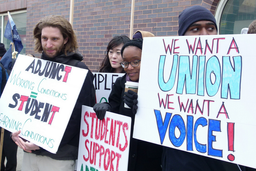The Bureau of Labor Statistics (BLS) job numbers for December are out. And guess what? They’re bad. The U.S. economy only added 74,000 public and private sector jobs in December, the slowest pace in the last three years and far lower than the 200,000 new jobs many experts were predicting. None of this should come as a surprise to the 10.4 million Americans officially looking for work.
But wait, there’s more “good” news. While the participation rate obscuring real unemployment is nothing new, the December numbers from the BLS highlight a disturbing post-recession trend in the job numbers. As Danielle Kurtzleben notes over at US News and World Report, the unemployment rate is falling, but the employment rate remains basically flat. That's because workers aren't finding jobs, they're just dropping out of the labor force at rates we haven’t seen in decades. The New York Times reports:
The one apparent bright spot in Friday’s report—a sharp drop in the unemployment rate to 6.7 percent from 7 percent—was tarnished because it largely resulted from people exiting the work force rather than because they landed jobs. The work force shrank by 347,000 in December, reversing a big gain from November, and returning the proportion of Americans in the labor force to its October level of 62.8 percent, the lowest in 35 years.
All of this underscores the reason for continuing to extend unemployment benefits for the 1.3 million Americans whose benefits expired at the end of last year and the need to make sure that those who have already “aged out” of unemployment benefits, or were never eligible for them, get the support they need.
Andrew Mortazavi is a Spring 2014 editorial intern. Follow him on Twitter at @andrewmortazavi.




